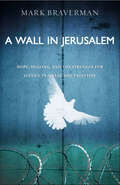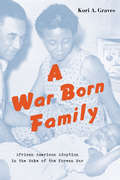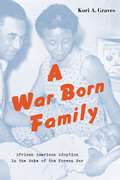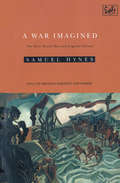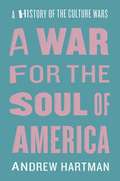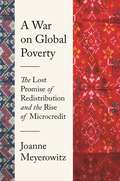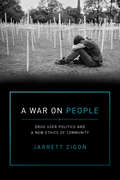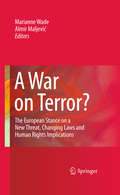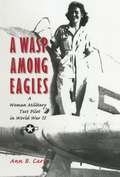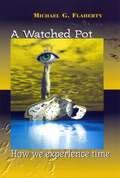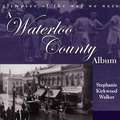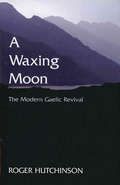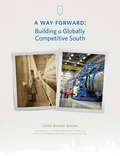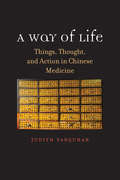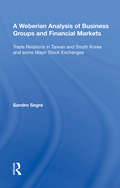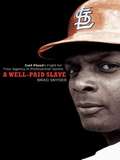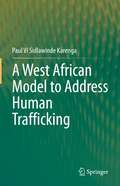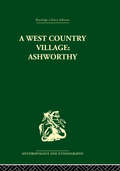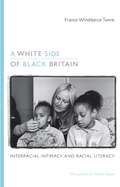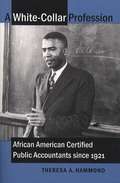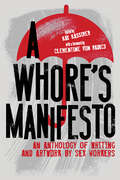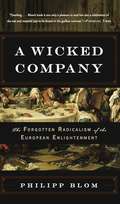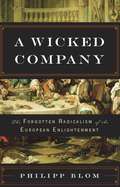- Table View
- List View
A Wall in Jerusalem: Hope, Healing, and the Struggle for Justice in Israel and Palestine
by Mark BravermanViolence in Israel and Palestine has become the norm.Do we even understand this conflict? Do we know where it comes from?Why can't the two sides reach agreement? Can Jews and Palestinians find a way to coexist?An American Jew, Mark Braverman thought he understood the reasons for Israel's existence. But when he visited the region and began to understand the forces that are fueling and perpetuating the conflict, he realized just how far we are from achieving peace. From the bustling communities on either side of the Jerusalem barrier, to the historical lessons of the Nazi Holocaust and South African apartheid, to the foremost voices in theology and conflict resolution today, Braverman answers the questions above and offers a course of action both at home and abroad to realize peace.
A War Born Family: African American Adoption in the Wake of the Korean War
by Kori A. GravesThe origins of a transnational adoption strategy that secured the future for Korean-black childrenThe Korean War left hundreds of thousands of children in dire circumstances, but the first large-scale transnational adoption efforts involved the children of American soldiers and Korean women. Korean laws and traditions stipulated that citizenship and status passed from father to child, which made the children of US soldiers legally stateless. Korean-black children faced additional hardships because of Korean beliefs about racial purity, and the segregation that structured African American soldiers’ lives in the military and throughout US society. The African American families who tried to adopt Korean-black children also faced and challenged discrimination in the child welfare agencies that arranged adoptions.Drawing on extensive research in black newspapers and magazines, interviews with African American soldiers, and case notes about African American adoptive families, A War Born Family demonstrates how the Cold War and the struggle for civil rights led child welfare agencies to reevaluate African American men and women as suitable adoptive parents, advancing the cause of Korean transnational adoption.
A War Born Family: African American Adoption in the Wake of the Korean War
by Kori A. GravesThe origins of a transnational adoption strategy that secured the future for Korean-black childrenThe Korean War left hundreds of thousands of children in dire circumstances, but the first large-scale transnational adoption efforts involved the children of American soldiers and Korean women. Korean laws and traditions stipulated that citizenship and status passed from father to child, which made the children of US soldiers legally stateless. Korean-black children faced additional hardships because of Korean beliefs about racial purity, and the segregation that structured African American soldiers’ lives in the military and throughout US society. The African American families who tried to adopt Korean-black children also faced and challenged discrimination in the child welfare agencies that arranged adoptions.Drawing on extensive research in black newspapers and magazines, interviews with African American soldiers, and case notes about African American adoptive families, A War Born Family demonstrates how the Cold War and the struggle for civil rights led child welfare agencies to reevaluate African American men and women as suitable adoptive parents, advancing the cause of Korean transnational adoption.
A War Imagined: The First World War and English Culture
by Samuel HynesBetween the opulent Edwardian years and the 1920s the First World War opens like a gap in time. England after the war was a different place; the arts were different; history was different; sex, society, class were all different.Samuel Hynes examines the process of that transformation. He explores a vast cultural mosaic comprising novels and poetry, music and theatre, journalism, paintings, films, parliamentary debates, public monuments, sartorial fashions, personal diaries and letters.Told in rich detail, this penetrating account shatters much of the received wisdom about the First World War. It shows how English culture adapted itself to the needs of killing, how our stereotypes of the war gradually took shape and how the nations thought and imagination were profoundly and irretrievably changed.
A War for the Soul of America: A History of the Culture Wars
by Andrew HartmanWhen Patrick Buchanan took the stage at the Republican National Convention in 1992 and proclaimed, "There is a religious war going on for the soul of our country,” his audience knew what he was talking about: the culture wars, which had raged throughout the previous decade and would continue until the century’s end, pitting conservative and religious Americans against their liberal, secular fellow citizens. It was an era marked by polarization and posturing fueled by deep-rooted anger and insecurity. Buchanan’s fiery speech marked a high point in the culture wars, but as Andrew Hartman shows in this richly analytical history, their roots lay farther back, in the tumult of the 1960s--and their significance is much greater than generally assumed. Far more than a mere sideshow or shouting match, the culture wars, Hartman argues, were the very public face of America’s struggle over the unprecedented social changes of the period, as the cluster of social norms that had long governed American life began to give way to a new openness to different ideas, identities, and articulations of what it meant to be an American. The hot-button issues like abortion, affirmative action, art, censorship, feminism, and homosexuality that dominated politics in the period were symptoms of the larger struggle, as conservative Americans slowly began to acknowledge--if initially through rejection--many fundamental transformations of American life. As an ever-more partisan but also an ever-more diverse and accepting America continues to find its way in a changing world, A War for the Soul of America reminds us of how we got here, and what all the shouting has really been about.
A War on Global Poverty: The Lost Promise of Redistribution and the Rise of Microcredit
by Joanne MeyerowitzA history of US involvement in late twentieth-century campaigns against global poverty and how they came to focus on women A War on Global Poverty provides a fresh account of US involvement in campaigns to end global poverty in the 1970s and 1980s. From the decline of modernization programs to the rise of microcredit, Joanne Meyerowitz looks beyond familiar histories of development and explains why antipoverty programs increasingly focused on women as the deserving poor.When the United States joined the war on global poverty, economists, policymakers, and activists asked how to change a world in which millions lived in need. Moved to the left by socialists, social democrats, and religious humanists, they rejected the notion that economic growth would trickle down to the poor, and they proposed programs to redress inequities between and within nations. In an emerging “women in development” movement, they positioned women as economic actors who could help lift families and nations out of destitution. In the more conservative 1980s, the war on global poverty turned decisively toward market-based projects in the private sector. Development experts and antipoverty advocates recast women as entrepreneurs and imagined microcredit—with its tiny loans—as a grassroots solution. Meyerowitz shows that at the very moment when the overextension of credit left poorer nations bankrupt, loans to impoverished women came to replace more ambitious proposals that aimed at redistribution.Based on a wealth of sources, A War on Global Poverty looks at a critical transformation in antipoverty efforts in the late twentieth century and points to its legacies today.
A War on People: Drug User Politics and a New Ethics of Community
by Jarrett ZigonIf we see that our contemporary condition is one of war and widely diffused complexity, how do we understand our most basic ethical motivations? What might be the aims of our political activity? A War on People takes up these questions and offers a glimpse of a possible alternative future in this ethnographically and theoretically rich examination of the activity of some unlikely political actors: users of heroin and crack cocaine, both active and former. The result is a groundbreaking book on how anti–drug war political activity offers transformative processes that are termed worldbuilding and enacts nonnormative, open, and relationally inclusive alternatives to such key concepts as community, freedom, and care.
A War on Terror?: The European Stance on a New Threat, Changing Laws and Human Rights Implications
by Marianne Wade Almir MaljevicThe events of September 11, 2001, have galvanized anti-terrorist efforts far beyond Ground Zero--particularly in Europe, where state responses to terror threats vary widely. In A War on Terror? The European Stance on a New Threat, Changing Laws and Human Rights Implications, an international panel of experts analyzes current trends and new developments in law enforcement and legal systems throughout the continent, including material from non-English-speaking countries that is seldom available to the broader academic community. Offering a succinct overview with special focus on criminal law, police procedure, immigration law, and human rights, the book provides unique insight into what the war on terror means to EU member and non-member countries; state supporters and critics of American anti-terrorist policy; nations with recent histories of outside terrorist attacks and those facing threats from homegrown entities. This comparative approach gives readers three levels of understanding: by country, as affecting the European Union as a whole, and in the context of the UN. Key areas covered in the book: Anti-terrorist policies across Europe, from England, Germany, France, and Spain to Slovenia, Croatia, and Bosnia and Herzegovina. Frontline issues: threat assessment, terror funding, the use of secret service agencies, effects on Muslim communities, and more. Technological developments, including cyber-terrorism and biometric surveillance. The conflict between human rights and heightened security measures (e.g., extraordinary renditions). The emerging intersection of criminal law with the law of war. While A War on Terror? is geared to specialists and students in the field, it will be of great interest to the wider legal community. Its synthesis of salient findings and expert perspectives enhances the ongoing debate on issues that have the potential to shape the future of global politics and policy.
A Wasp Among Eagles: A Woman Military Test Pilot in World War II
by Ann CarlBefore World War II most Americans did not believe that the average woman could fly professionally, but during the war more than a thousand women pilots proved them wrong. These were the Women Airforce Service Pilots (WASPs), who served as military flyers on the home front. In March 1944 one of them, Ann Baumgartner, was assigned to the Fighter Flight Test Branch at Wright Field in Dayton, Ohio. There she would make history as the only woman to test-fly experimental planes during the war and the first woman to fly a jet. A WASP among Eagles is the first-person story of how Baumgartner learned to fly, trained as a WASP, and became one of the earliest jet-age pioneers. Flying such planes as the Curtiss A-25 Helldiver, the Lockheed P-38, and the B-29 Superfortress, she was the first woman to participate in a host of experiments, including in-air refueling and flying the first fighter equipped with a pressurized cockpit. But in evaluating the long-awaited turbojet-powered Bell YP-59A, she set a "first" record that would remain unchallenged for ten years.
A Watched Pot: How We Experience Time
by Michael G. FlahertyTime, it has been said, is the enemy. In an era of harried lives, time seems increasingly precious as hours and days telescope and our lives often seem to be flitting past. And yet, at other times, the minutes drag on, each tick of the clock excruciatingly drawn out. What explains this seeming paradox? Based upon a full decade's empirical research, Michael G. Flaherty's new book offers remarkable insights on this most universal human experience. Flaherty surveys hundreds of individuals of all ages in an attempt to ascertain how such phenomena as suffering, violence, danger, boredom, exhilaration, concentration, shock, and novelty influence our perception of time. Their stories make for intriguing reading, by turns familiar and exotic, mundane and dramatic, horrific and funny. A qualitative and quantitative tour de force, A Watched Pot presents what may well be the first fully integrated theory of time and will be of interest to scientists, humanists, social scientists and the educated public alike. A Choice Outstanding Academic Book.
A Waterloo County Album: Glimpses of the Way We Were
by Stephanie Kirkwood WalkerCommended for the 2003 Honourable Mention for Superb Craftsmanship in Production The early settlers of Waterloo County - Mennonites, Germans, and Scots - built enterprising communities in a land of rivers, rolling hills, and fields. Today the linked cities of Kitchener, Waterloo, and Cambridge are still surrounded by small towns with strong rural traditions. This photographic history of the region contains 130 black and white images from as early as 1880, recording the cultural landscape, the buildings, parks, markets, fairs, and parades. Some of the photographs will tease your fancy with whispers of the pioneers’ spirit, while others capture the energy of events and dare us to interpret the past.
A Waxing Moon: The Modern Gaelic Revival
by Roger HutchinsonThirty years ago, the Gaelic language and culture which had been eminent in Scotland for 1,300 years seemed to be in the final stages of a 200-year terminal decline. The number of Gaelic speakers in Scotland had fallen tenfold over the previous century. The language itself was commonplace only in the scattered communities of the north-west Highlands and Hebrides.By the early years of the 21st century, however, a sea-change had taken place. Gaelic - for so long a subject of mockery and hostility - had become what some termed 'fashionable'. Gaelic-speaking jobs were available; Gaelic-medium education was established in many areas; and politicians and business-people saw benefits in acting as friends of the culture. While the numbers of Gaelic-speakers continued to fall as older people passed away, the decline was slowed and for the first time in 100 years the percentage of young people using the language began to rise proportionately. What had happened was a kind of renaissance: a Gaelic revival that manifested itself in popular music, literature, art, poetry, publishing, drama, radio and television. It was a phenomenon as obvious as it was unexpected. And at the heart of that movement lay education. A Gaelic Modern History will tell the story of one institution, Sabhal Mor Ostaig, the Gaelic College in Skye that has stood at the centre of this revival. But, chiefly, the book will examine how a venerable culture was given hope for the future at the point when all seemed lost. It recounts the scores of personalities, from Sorley Maclean and Runrig to Michael Forsyth and Gordon Brown, who have become involved in that process.
A Way Forward
by Peter A. Coclanis Daniel P. GittermanIn the last half century, North Carolina and the South have experienced rapid economic growth. Much of the best analysis of this progress came from two North Carolina-based research organizations: the Southern Growth Policies Board and MDC (originally a project of the North Carolina Fund). Their 1986 reports are two of the best assessments of the achievements and limitations of the so-called Sunbelt boom. On November 17, 2011, the Global Research Institute at the University of North Carolina at Chapel Hill and the Institute for Emerging Issues at North Carolina State University co-hosted a public discussion to build on these classic reports and to offer fresh analyses of the current challenges facing the region. A Way Forward, which issued from this effort, features more than thirty original essays containing recommendations and strategies for building and sustaining a globally competitive South.
A Way of Life: Things, Thought, and Action in Chinese Medicine (The Terry Lectures Series)
by Judith FarquharA short and thoughtful introduction to traditional Chinese medicine that looks beyond the conventional boundaries of Western modernism and biomedical science Traditional Chinese medicine is often viewed as mystical or superstitious, with outcomes requiring naïve faith. Judith Farquhar, drawing on her hard-won knowledge of social, intellectual, and clinical worlds in today’s China, here offers a concise and nuanced treatment that addresses enduring and troublesome ontological, epistemological, and ethical questions. In this work, which is based on her 2017 Terry Lectures “Reality, Reason, and Action In and Beyond Chinese Medicine,” she considers how the modern, rationalized, and scientific field of traditional Chinese medicine constructs its very real objects (bodies, symptoms, drugs), how experts think through and sort out pathology and health (yinyang, right qi/wrong qi, stasis, flow), and how contemporary doctors act responsibly to “seek out the root” of bodily disorder. Through this refined investigation, East-West contrasts collapse, and systematic Chinese medicine, no longer a mystery or a pseudo-science, can become a philosophical ally and a rich resource for a more capacious science.
A Way of Seeing
by Margaret Mead Rhoda MetrauxThese essays are personal responses to events at different moments in time; as such, they reflect changes through which all of us have been living. However, they are grouped here not sequentially but in accordance with the standpoint from which they were written.
A Weberian Analysis of Business Groups and Financial Markets: Trade Relations in Taiwan and Korea and some Major Stock Exchanges
by Sandro SegreMoral economy, as a set of rules which regulate market transactions, has been the object of much research and debate since the 1980s; it has also been the focus of classical sociological authors such as Weber, Simmel and Toennies. Weber in particular examined the rules of the moral economy in the financial markets, and this volume sheds light on his contribution to the subject. The book formulates two models of business relations - one oligopolistic model, the other based on free competition - which are derived from Weber and Simmel's writings and which represent alternative instances of the moral economy. Empirical case studies in the form of South Korea and Taiwan are included to exemplify the two models and to highlight the consequences of adopting one model over the other. The volume also examines the conduct of actors in some of the leading financial markets, with reference to Weber's writings on the 19th century London and Berlin Stock Exchanges.
A Well-Paid Slave
by Brad SnyderAfter the 1969 season, the St. Louis Cardinals traded their star center fielder, Curt Flood, to the Philadelphia Phillies, setting off a chain of events that would change professional sports forever. At the time there were no free agents, no no-trade clauses. When a player was traded, he had to report to his new team or retire. Unwilling to leave St. Louis and influenced by the civil rights movement, Flood chose to sue Major League Baseball for his freedom. His case reached the Supreme Court, where Flood ultimately lost. But by challenging the system, he created an atmosphere in which, just three years later, free agency became a reality. Flood’s decision cost him his career, but as this dramatic chronicle makes clear, his influence on sports history puts him in a league with Jackie Robinson and Muhammad Ali. .
A West African Model to Address Human Trafficking
by Paul V.I. KarengaThis book describes the nature of trafficking in persons in West Africa, focusing on labor and sexual exploitation in the region, and recommends tailor-made solutions established by the Catholic Church in light of governmental authorities’ failure to effectively combat this scourge of humanity. While states’ efforts to fulfill their international obligations in developing anti-trafficking legislations are recognized, their failure to carry out prosecutions of offenders and ensure protection of the victims reveals that law alone is not a sufficient instrument for realizing human rights and improving people’s lives. Faced with the sobering background of less than successful efforts by governmental entities to end the trade in humans, this research study recommends adopting essential elements of Catholic social teaching, which rests on the inherent dignity of human beings allowing the development of political, socio-cultural, and religious reforms that will increase the effectiveness of existing legislation designed to combat trafficking. This faith-based approach highlights the role that religion may play in fulfilling the discretionary provisions of the Palermo Protocol by promoting the welfare and protecting the life and dignity of the victims. Additionally, religion is composed of sound moral ethics that determine people's behavior to refrain from the sinful conduct of trafficking. It also creates a sense of ethical responsibility that promotes supply chain transparency and ethical purchasing as well as advocating social reforms and anti-trafficking legislations initiatives. In fact, the author's approach, may be a model for other regions in the world and will be of interest to scholars, law and policy makers, human rights advocates and law enforcement agents working in the field of trafficking in persons.
A West Country Village Ashworthy
by W.M. WilliamsThis volume examines the effects of rural depopulation as a process on the structure of family and kinship within one small rural area, analysing the spatial relationships of social and economic change. Part One documents these relationships in the context of family farming; the second part is largely devoted to the effects of demographic change on the structure of family and kinship within one small community.
A White Side of Black Britain: Interracial Intimacy and Racial Literacy
by France Winddance TwineA White Side of Black Britain explores the racial consciousness of white women who have established families and had children with black men of African Caribbean heritage in the United Kingdom. Filling a gap in the sociological literature on racism and antiracism, France Winddance Twine introduces new theoretical concepts in her description and analysis of white "transracial" mothers raising their children of African Caribbean ancestry in a racially diverse British city. Varying in age, income, education, and marital status, the transracial mothers at the center of Twine's ethnography share moving stories about how they cope with racism and teach their children to identify and respond to it. They also discuss how and why their thinking about race, racism, and whiteness changed over time. Interviewing and observing more than forty multiracial families over a decade, Twine discovered that in most of them, the white woman's racial consciousness and her ability to recognize and negotiate racism were derived as much from her relationships with her black partner and his extended family as from her female friends. In addition to the white birth mothers, Twine interviewed their children, spouses, domestic partners, friends, and members of their extended families. Her book is best characterized as an ethnography of racial consciousness and a dialogue between black and white family members about the meaning of race, racism, and whiteness. It includes intimate photographs of the family members and their communities.
A White-Collar Profession
by Theresa A. HammondAmong the major professions, certified public accountancy has the most severe underrepresentation of African Americans: less than 1 percent of CPAs are black. Theresa Hammond explores the history behind this statistic and chronicles the courage and determination of African Americans who sought to enter the field. In the process, she expands our understanding of the links between race, education, and economics. Drawing on interviews with pioneering black CPAs, among other sources, Hammond sets the stories of black CPAs against the backdrop of the rise of accountancy as a profession, the particular challenges that African Americans trying to enter the field faced, and the strategies that enabled some blacks to become CPAs. Prior to the 1960s, few white-owned accounting firms employed African Americans. Only through nationwide networks established by the first black CPAs did more African Americans gain the requisite professional experience. The civil rights era saw some progress in integrating the field, and black colleges responded by expanding their programs in business and accounting. In the 1980s, however, the backlash against affirmative action heralded the decline of African American participation in accountancy and paved the way for the astonishing lack of diversity that characterizes the field today.
A Whore's Manifesto: An Anthology of Writing and Artwork by Sex Workers
by Kay KassirerSex work was once thought to be anathema to women's liberation. Now, to some, we represent the tenacity of women's struggles under patriarchy and capitalism—that is, at least, the white, straight, cis, able-bodied sex workers who don't engage in actual sex with clients. These are the workers who get the glossy media profiles and get touted as feminist icons. But the red umbrella is wide and covers so many: escorts, sugar babies, strippers, session wrestlers, cam performers, fetish models, DIY queer porn stars, and the full range of gender, race, and ability. Our work and our identities are as vast and variable as the spectrum of sexuality itself. We do the work. In the streets, in the clubs, in hotel rooms, and in play party dungeons. We make dreams come true so we can afford a place to sleep. We do business in a marketplace that politicians and police are constantly burning down for our "own safety and dignity." We have high heels and higher anxiety. This isn't a collection of sob stories of heartbroken whores. This is a testament of life at ground zero of sexual discourse, the songs of canaries in the coal mines of sex, gender, class, race, and disability. We may dance on the table, but we still demand our seat at it. Sex workers of the world unite. This is A Whore's Manifesto.
A Wicked Company
by Philipp BlomThe flourishing of radical philosophy in Baron Thierry Holbach's Paris salon from the 1750s to the 1770s stands as a seminal event in Western history. Holbach's house was an international epicenter of revolutionary ideas and intellectual daring, bringing together such original minds as Denis Diderot, Laurence Sterne, David Hume, Adam Smith, Ferdinando Galiani, Horace Walpole, Benjamin Franklin, Guillaume Raynal, and Jean-Jacques Rousseau.In A Wicked Company, acclaimed historian Philipp Blom retraces the fortunes of this exceptional group of friends. All brilliant minds, full of wit, courage, and insight, their thinking created a different and radical French Enlightenment based on atheism, passion, reason, and truly humanist thinking. A startlingly relevant work of narrative history, A Wicked Company forces us to confront with new eyes the foundational debates about modern society and its future.
A Wicked Company: The Forgotten Radicalism of the European Enlightenment
by Philipp BlomThe acclaimed author of The Vertigo Years tells the remarkable story of the Parisian salon that hosted the eighteenth century's greatest minds and changed the course of Western philosophy
A Wicked Pursuit: Breconridge Brothers Book 1 (Breconridge Brothers)
by Isabella BradfordFor fans of Julia Quinn, Eloisa James and Sarah MacLean, comes Isabella Bradford's enthralling new trilogy of London's most scandalous rakes, the Breconridge Brothers, who are about to lose their hearts... As the eldest son of the Duke of Breconridge, Harry Fitzroy is duty-bound to marry well. Lady Julia Barclay, the catch of the season, seems the perfect candidate. But a fall from his horse throws his plan awry and he finds himself trapped in the country in the care of Julia's younger sister. Harry has never met a woman like Lady Augusta. Utterly without artifice, Gus seems to care not a fig for society. After a taboo kiss awakens an unexpected passion, Harry realizes he'd almost given his heart to the wrong sister. Now he must use his most seductive powers to convince Gus that she belongs with him - as his equal, his love, his wife.Before the Breconridge Brothers, came the Wylder sisters. Don't miss a moment of the romantic and captivating debut trilogy from Isabella Bradford: When You Wish Upon a Duke, When The Duchess Said Yes and When The Duke Found Love.
